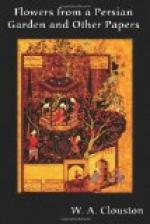but absolutely unlawful, to commit these ancient and
carefully-preserved traditions to writing; but after
the second destruction of Jerusalem, under Hadrian,
when the Jewish people were scattered over the world,
the system of oral transmission of these traditions
from generation to generation became impracticable,
and, to prevent their being lost, they were formed
into a permanent record about A.D. 190, by Rabbi Jehudah
the Holy, who called his work
Mishna, or the
Secondary Laws. About a hundred years later a
commentary on it was written by Rabbi Jochonan, called
Gemara, or the Completion, and these two works
joined together are known as the (Jerusalem)
Talmud,
or Directory. But this commentary being written
in an obscure style, and omitting many traditions
known farther east, another was begun by Rabbi Asche,
who died A.D. 427, and completed by his disciples
and followers about the year 500, which together with
the Mishna formed the Babylonian Talmud. Both
versions were first printed at Venice in the 16th
century—the Jerusalem Talmud, in one folio
volume, about the year 1523; and the Babylonian Talmud,
in twelve folio volumes, 1520-30. In the 12th
century Moses Maimonides, a Spanish Rabbi, made an
epitome, or digest, of all the laws and institutions
of the Talmud. Such, in brief, is the origin
and history of this famed compilation, which has been
aptly described as an extraordinary monument of human
industry, human wisdom, and human folly.
By far the greater portion of the Talmud is devoted
to the ceremonial law, as preserved by oral tradition
in the manner above explained; but it also comprises
innumerable sayings or aphorisms of celebrated Rabbis,
together with narratives of the most varied character—legends
regarding Biblical personages, moral tales, fables,
parables, and facetious stories. Of the rabbinical
legends, many are extremely puerile and absurd, and
may rank with the extravagant and incredible monkish
legends of mediaeval times; some, however, are characterised
by a richness of humour which one would hardly expect
to meet with in such a work; while not a few of the
parables, fables, and tales are strikingly beautiful,
and will favourably compare with the same class of
fictions composed by the ancient sages of Hindustan.
It is a singular circumstance, and significant as
well as singular, that while the Hebrew Talmud was,
as Dr. Barclay remarks, “periodically banned
and often publicly burned, from the age of the Emperor
Justinian till the time of Pope Clement VIII,”
several of the best stories in the Gesta Romanorum,
a collection of moral tales (or tales “moralised”)
which were read in Christian churches throughout Europe
during the Middle Ages, are derived mediately or immediately
from this great storehouse of rabbinical learning.[55]




